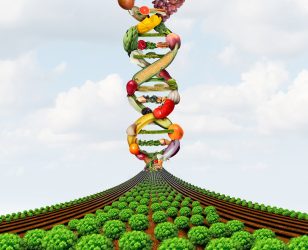Can GMOs and clean label co-exist?
- Like
- Digg
- Del
- Tumblr
- VKontakte
- Buffer
- Love This
- Odnoklassniki
- Meneame
- Blogger
- Amazon
- Yahoo Mail
- Gmail
- AOL
- Newsvine
- HackerNews
- Evernote
- MySpace
- Mail.ru
- Viadeo
- Line
- Comments
- Yummly
- SMS
- Viber
- Telegram
- Subscribe
- Skype
- Facebook Messenger
- Kakao
- LiveJournal
- Yammer
- Edgar
- Fintel
- Mix
- Instapaper
- Copy Link
Posted: 18 November 2022 | Jaclyn Bowen | No comments yet
Jaclyn Bowen looks at the market drivers for both GMOs and clean label and examines whether the two conflicting, concurrent trends can continue on their trajectories simultaneously.


Can two opposing trends continue to grow harmoniously?
Population dynamics, land availability, and climate change are all variables in our complex and interdependent global agriculture industry. It is expected that the world’s population will grow to almost 10 billion by 2050, leading to an increase in agricultural demand by roughly 50 percent compared to a decade ago.
Genetic modification/bioengineering has long been touted as a solution for a sustainable global food supply. At the same time, an increasingly educated, sceptical and cynical consumer base is challenging that premise and demanding transparency.
According to Mordor Intelligence, the global clean label ingredients market is projected to grow at a CAGR of 6.75 percent, during the forecast period (2021-2026). The Mordor Intelligence report acknowledged that the COVID-19 pandemic had a significant effect on the clean label ingredient market. The buying behaviour of consumers changed; they have become even more cautious about their food and are eating healthier than usual. All the while, the global food industry continues to be dealing with current realities of inflationary pressures and supply chain constraints.
So how does the global food industry look ahead and create healthy food at quantities enough to feed the world while at the same time catering to valued attributes that consumers demand most? Can genetic modification and clean label co-exist?
What’s driving clean label growth?
The ‘Global Clean Label Ingredients Market: Focus on Ingredients, Application, and Country-Wise Analysis – Analysis and Forecast, 2020-2026’ indicates that the worldwide clean label ingredients market is expected to reach $32.08 billion by 2026.
If your supply chain partners, manufacturing process and sustainability efforts were published on the front page of a major media outlet, would you be proud?
Consumers have become highly educated about the detrimental effects of unnatural and processed foods and artificial ingredients. As a result, consumers are demanding transparency. Clean label ingredients are the food industry’s response to increasing consumer demand for consumables without questionable ingredients. At the same time, clean label is proving to be an evolving concept that has shifted in its meaning and significance over the years. Most recently, the emerging issue of industrial and environmental contamination of finished food products has brands, retailers and regulatory bodies scrambling to satisfy new consumer expectations around heavy metals, pesticide residues and packaging migration issues from BPA/BPS, and phthalates. Because of consumer perceived government inaction and corporate apathy, consumers are taking it upon themselves to serve as the arbiters of safety for their households with brands having to anticipate these new consumer needs and expectations.
The GMO market
The non-GMO and GMO movements have also been going through their own share of change. The Non-GMO Project, the leading North American Non-GMO certification standard development and advocacy organisation, has been experiencing significant growth over the past decade. In fact, SPINS, the wellness-focused data and trends company, recently reported about 52 percent of overall plant-based sales are Non-GMO Project Verified.
Synbio and GMO labels
In a new case study of growth of sales from 2019-2021, SPINS data found that Non-GMO Project Verified frozen plant-based meat alternatives rose 71.7 percent. At the same time, the Non-GMO Project standards have had to adapt to evolving food technology trends – namely synthetic biology. Synthetic biology, often called ‘synbio’, is an emerging application of genetic modification that involves the practice of changing an organism such as yeast or algae so that it makes a substance it is not able to make naturally. The process requires artificially created DNA that mimics naturally occurring DNA in other organisms. These ingredients can currently be found in food, supplements and cosmetics, and are largely unregulated let alone labelled. When it comes to the global food and consumer product supply chain and synbio, the proverbial genie is out of the box.


Transparency is key
In short, yes. But for clean label and GMOs to co-exist, it will require consumers pushing for transparency so that industry remains honest.
While food trends come and go, I cannot imagine consumer demand for transparency to ever go in reverse. With social media, smart phones, the use of QR codes, and whether its shopping for cars, electronics or food, information is always right at our fingertips. I can only anticipate that transparency expectations will accelerate. Ultimately, consumers will use their dollars as votes for the food systems and attributes that they value.
Consumers want to know what they’re eating, or at least studies make it seem that way. A report by Response Media found that 99 percent of people want transparency in their fresh food products, 98 percent want transparency in packaged foods, and 70 percent stated that what they buy is always or often influenced by transparency. As reported by Food Dive, “transparency has been one of the biggest buzzwords in the food business in recent years.”
So what do we mean when we say ‘transparency?’ Simply, it means knowing how a product was made. A transparent food brand would provide its customers with information on the product’s ingredients, sourcing, production process, sustainability, and so on.
Ultimately, consumer economics will pull through industry and brand change. Nimble brands that quickly adapt and align with evolving consumer expectations will win consumer hearts, minds and, subsequently, shelf space and market share. So as a brand evaluating your strategy, do so with transparency in mind.
Ask yourself this: if your supply chain partners, manufacturing process and sustainability efforts were published on the front page of a major media outlet, would you be proud?
About the author
Jaclyn Bowen MPH, MS is the Executive Director of Clean Label Project and a food safety and quality systems engineer. Prior to coming to Clean Label Project, she spent 15 years at the World Health Organization Collaborating Centre, NSF International, working on the creation and enforcement of food safety and water quality standards and compliance systems.
Related topics
Clean Label, Free From, Genetic modification (GMO), The consumer, Traceability
Related organisations
Food Dive, Mordor Intelligence, Non-GMO Project, Response Media, SPINS, United States Department of Agriculture (USDA)








